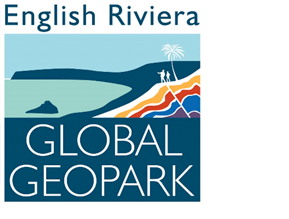Marine LifeThe high level of biodiversity in the waters surrounding The English Riviera UNESCO Globall Geopark has previously been recognised, with the region being described as “the jewel in South Devon’s crown” for marine wildlife. The 400 million year geological journey of the English Rivera has created an intricate coastline with a mosaic of headlands, coastal cliffs, rocky islands and sheltered coves interwoven by seafront proms and bustling harbours. In turn, that geology, effects the life found both above and below the water making the marine environment of Tor Bay is so special it is protected by two international designations, Marine Conservation Zone and Special Area of Conservation. The English Riviera UNESCO Global Geopark Seaside Code Explore beneath our waters with us, via our youtube videos.
Discover marine species when you explore our Geopark 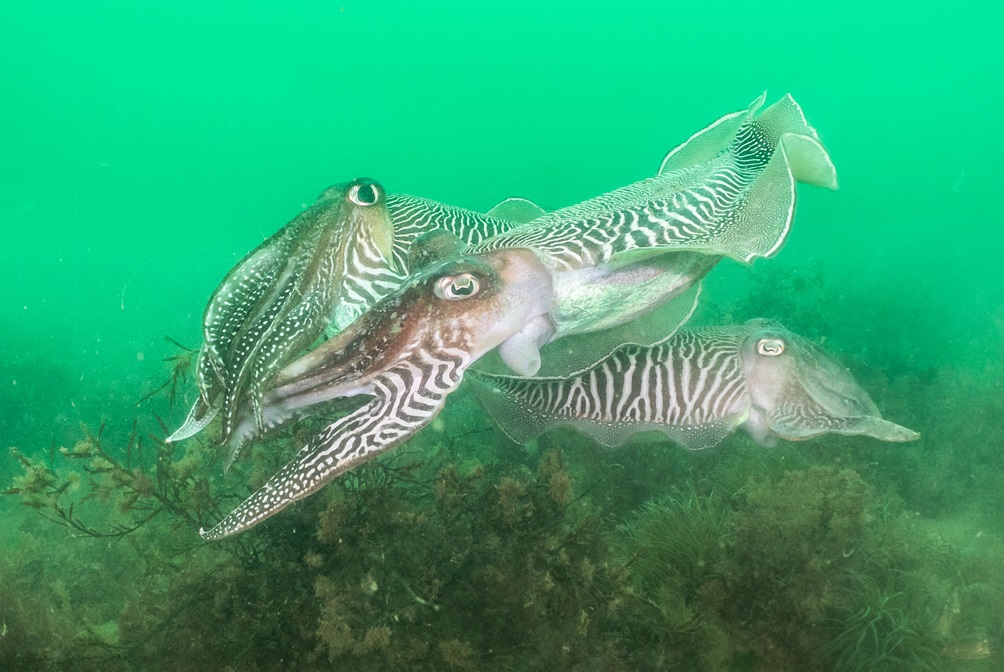 Cuttlefish are related to squids and octopuses – a group of molluscs known as cephalopods. You may have seen the chalky internal shell, called a cuttlebone washed up on beaches around our Geopark.
Cuttlefish are related to squids and octopuses – a group of molluscs known as cephalopods. You may have seen the chalky internal shell, called a cuttlebone washed up on beaches around our Geopark.Length: up to 45cm Average Lifespan: 2 years Common cuttlefish are the largest found in UK seas and a fierce predator. They make light work of crabs, fish and even small cuttlefish! They live in water up to 200 metres deep but come to shallow waters to breed in spring. Their eggs are dyed black with cuttlefish ink, which gives them the appearance of grapes – giving them their name ‘sea grapes’. 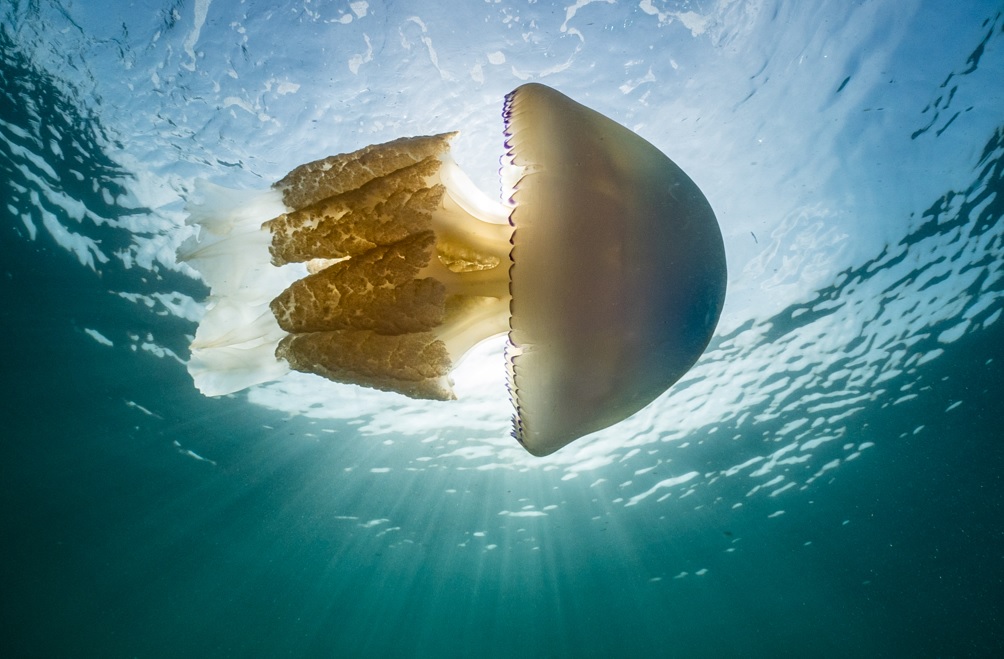 Barrel Jellyfish are giants of the jellyfish world, these incredible creatures are the UK’s largest jellyfish. They can grow up to 90cm across and weigh nearly 35kg.
Barrel Jellyfish are giants of the jellyfish world, these incredible creatures are the UK’s largest jellyfish. They can grow up to 90cm across and weigh nearly 35kg.These large jellyfish swarm in warmer coastal waters in late spring and often wash up on our beaches in May or June. Their favourite meal is plankton, which can be found in shallow waters. They have eight frilly arms, which contain their small stinging tentacles and surround hundreds of little mouths! The sting of the barrel jellyfish is not normally harmful to humans. 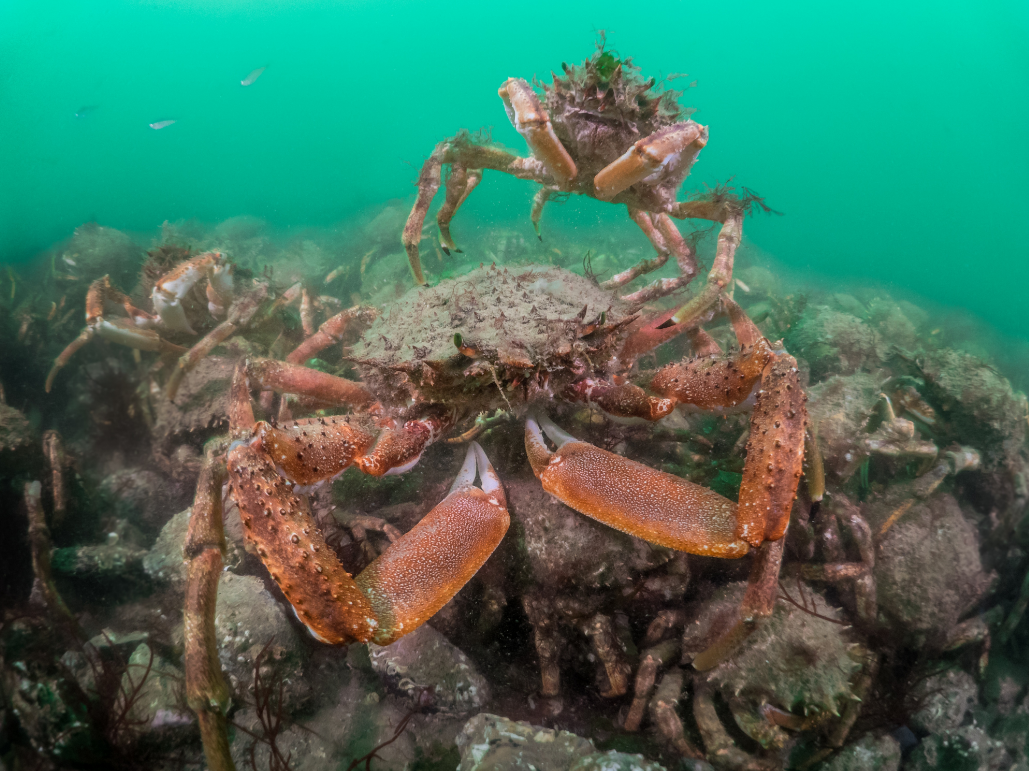
The Spiny Spider crab is also known as the European spider crab. It is a large, orange crab with long spindly legs like a spider and a distinctive spiny shell. Their oval shells are often covered in algae, giving them a green hairy look! They're not particularly picky eaters and will feed on seaweed, mussels, starfish and well, anything else they can get their claws on.
Spider crabs are easy to identify, they are a large orange crab with long, spindly legs like a spider. They have an oval, spiky shell that is often covered in algae. They are larger than great spider crabs, which have a pear-shaped shell.
Spider crabs are common across the South and West coasts of England and Wales; however they are absent from North Sea, Scotland and Northern England.
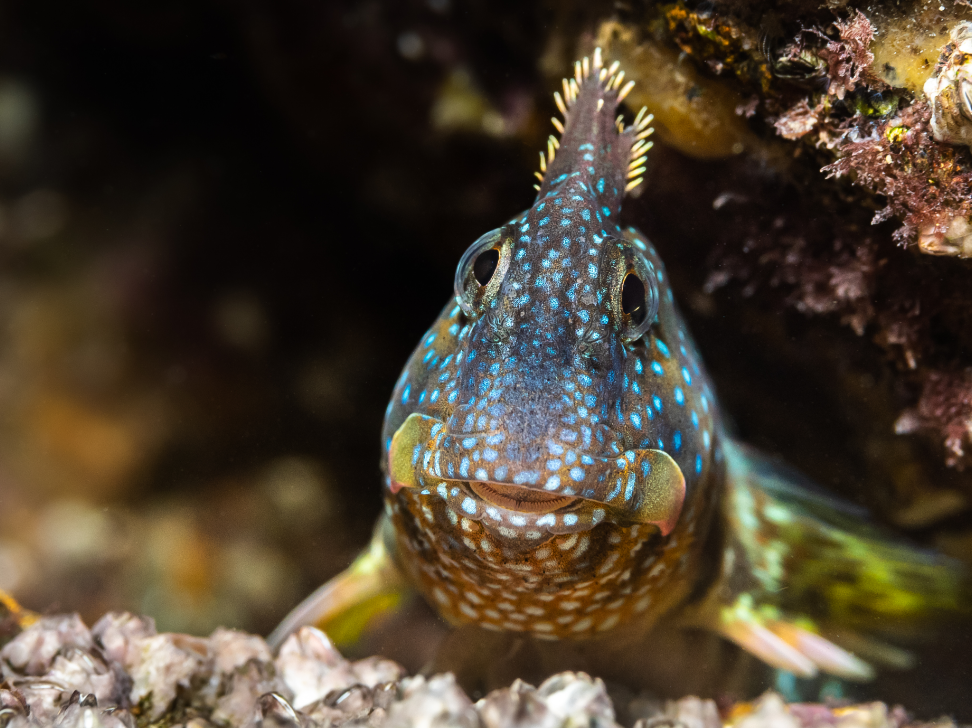 Montagu's blennies are found around the coasts of southwest Britain, where they're at the northern limit of their range. They live on wave-battered rocky shores, often in rock pools on the shore itself. They can even survive spending some time out of the water at low tide, sheltering under rocks and seaweed and breathing air.
Montagu's blennies are found around the coasts of southwest Britain, where they're at the northern limit of their range. They live on wave-battered rocky shores, often in rock pools on the shore itself. They can even survive spending some time out of the water at low tide, sheltering under rocks and seaweed and breathing air.Montagu's blennies are most active during the day, especially at high tide. They mainly feed on algae and barnacles, biting off the food-catching limbs that stick out from their shells, though younger fish have more varied diets. In Britain, Montagu's blennies breed in summer. Males attempt to attract females with a courtship display, rocking their head from side to side. If a female is impressed, she lays clumps of eggs that stick to rocks. The male guards the eggs and fans them with his tail to keep them aerated. Found in southwest Britain, down to northwest Africa and into the Mediterranean and the Black Sea. 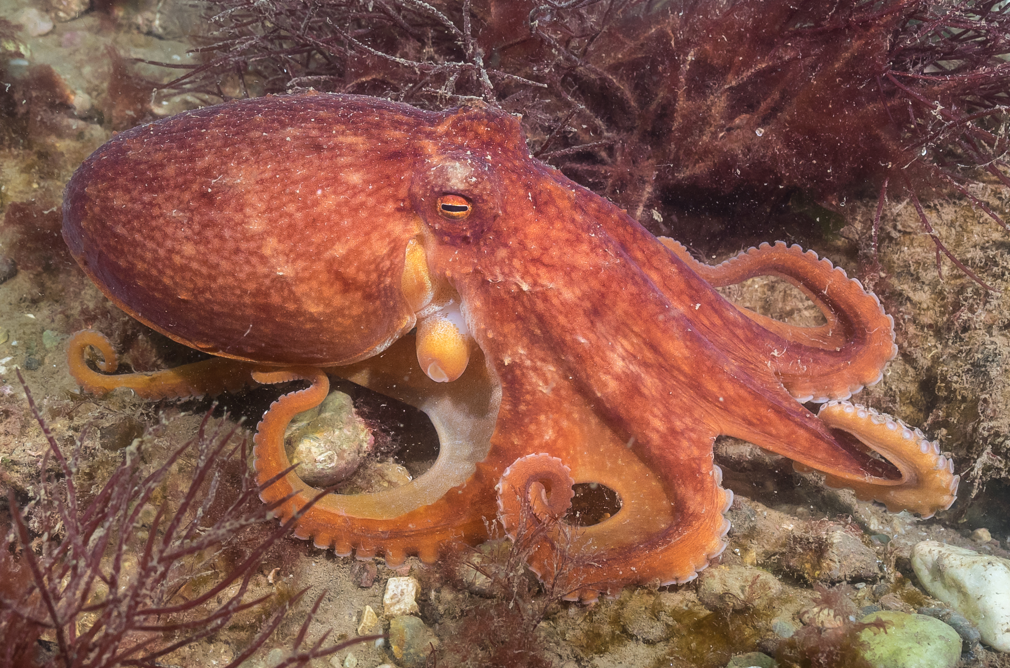
Common octopus generally live in rockier areas and in shallow water, under fifty metres deep. They have eight arms each of which has two rows of suckers which have receptors which allow the octopus to taste whatever it is touching. The beak-like mouth of the common octopus is located in the centre of the underside of the octopus’s body. The colour of the common octopus is not fixed and changes to adapt to its surroundings.
All octopus species are known to be extremely intelligent – certainly the most intelligent invertebrate species in the world. Common octopus have also been recorded distinguishing the difference between different shapes, and displaying observational learning, proving they have some form of long term memory. In the wild, the common octopus has also been known to steal crabs and lobsters out of pots and then find their way out of the pot, and have been seen using empty shells as a form of protection against predators. 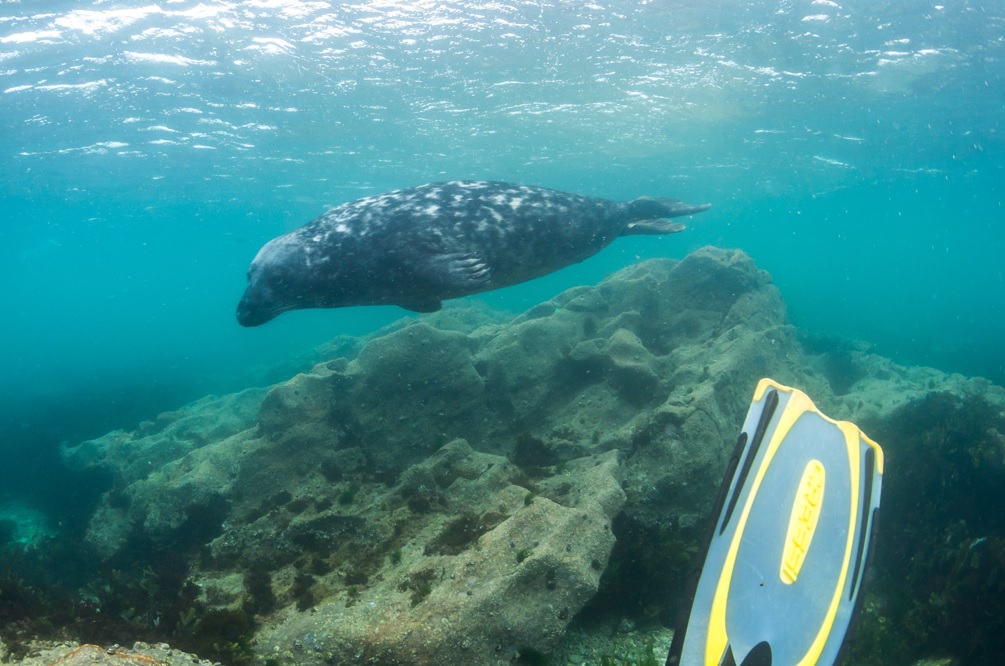
The Grey Seal is the larger of the two UK seal species. If you catch a good look at them you’ll see how they got their scientific name Halichoerus grypus – it means hook-nosed sea pig!
English Riviera UNESCO Global Geopark Marine Designations The marine area of the ERUGGp is incorporated into Lyme Bay and Torbay Special Area of Conservation (SAC) - located between Mackerel Cove and Dartmouth. Designated to protect reefs and 85 sea caves which are of international importance. Surfaces and walls inside the caves are home to a variety of delicate sponges, bryozoan crusts, pink sea fingers, anemones and cup corals. The SAC carries no statutory protection, it is covered by the SSSI national legislation, as well as certain regulations under the Marine Conservation Zone. The second marine designation of international significance is that of Marine Conservation Zone. MCZs protect typical, rare or declining habitats and species found in our seas. The Torbay Marine Conservation Zone (MCZ) was designated in November 2013. It is an inshore site covering the area of coastline between Oddicombe Beach and Sharkham Point, protecting a total area of approximately 20 km2. Beginning at the coastline, the boundary extends between 1 to 2.5km out to sea and includes Hope’s Nose near Torquay and Berry Head near Brixham. Extending from the shoreline out to a depth of 30 metres the site includes a range of habitats exposed to different environmental conditions. This variation creates an area that is capable of supporting a rich array of marine wildlife. The inshore areas of Torbay’s natural harbour are predominantly soft, muddy sands which are characterised by animals such as heart urchins and brittle stars. The less muddy sand found closer towards the shore holds dense populations of species including razor clams whereas the site’s rocky areas support sponges, sea squirts, seaweeds, and seagrasses. Seagrasses are plants with green, long, narrow, ribbon-shaped leaves and are the only flowering plant that can live in seawater and pollinate whilst submerged. Seagrass (Zostera marina) beds provide a habitat for a wide range of animals, such as seahorses and pipefish, which shelter amongst the leaves, as well as molluscs and worms which burrow into the roots and surrounding sediments. They also act as nursery areas for a range of animals giving protection to marine species of commercial importance such as bass and cuttlefish. The nationally rare long-snouted seahorse also inhabits seagrass beds and is found within Torbay MCZ. The seagrasses and their associated carbonate-rich epiphytes and associated protists are an important ‘sink’ for CO2 and are much quoted as important in controlling climate change. |
